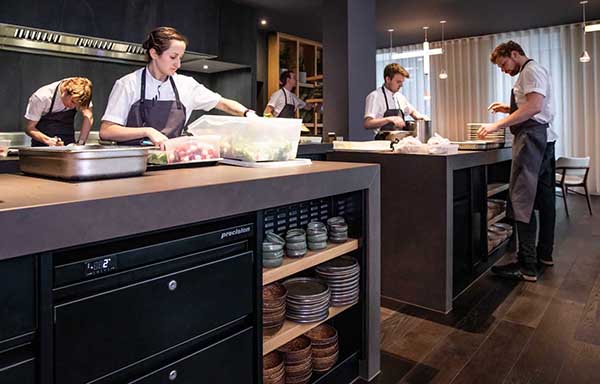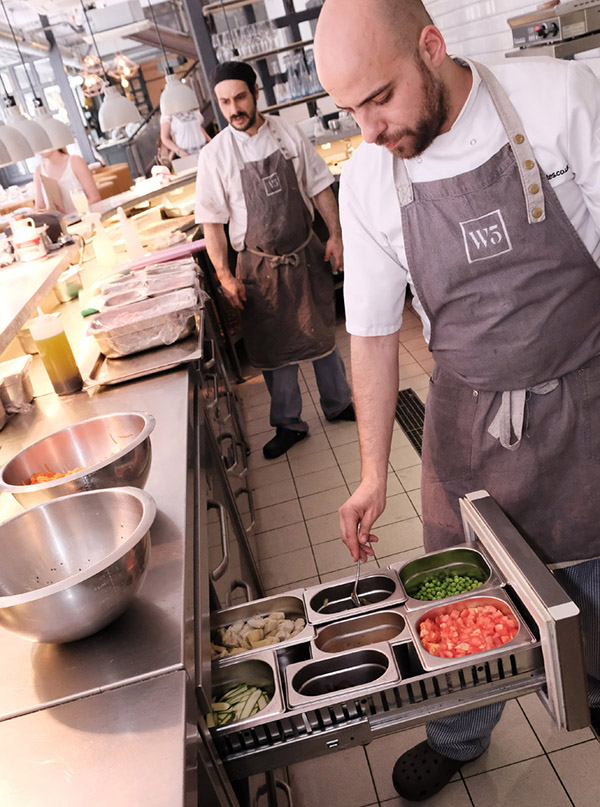Cool customers: which next-generation refrigeration is right for you
With European regulations soon bringing an end to the use of a common refrigerant, many operators are looking for alternatives. Ian Boughton takes a look at what's on the market
The kitchen refrigeration sector is in the middle of massive change, with all manufacturers heavily involved. Refrigeration suppliers say it will soon affect every fridge in a conventional kitchen.
"Our sector is undergoing the largest change in living memory," says Roz Scourfield, national sales manager at Hoshizaki UK. "Continuous updates to EU legislation are forcing manufacturers to more environmentally friendly developments. The choice of purchasing energy-efficient refrigeration has now virtually been taken out of operators' hands."
A brief explanation of this is that the widest-used refrigerant in the industry is being made illegal. R404A was introduced 20 years ago as a replacement for ozone-depleting refrigerants. It may not have been perfectly energy-efficient, and it has a too-high Global Warming Potential (GWP), but it filled an urgent need at the time, and is still widely used.
But now, European regulations say that any refrigerant with a high GWP will be banned, and so many manufacturers are turning to one called R290. This has a low environmental impact and many makers say it will be better-performing and more cost-effective for users.
Hoshizaki's new Snowflake series of refrigeration, freezer and blast chiller units will all use the R290 refrigerant and be fitted with Hoshizaki's ‘Tropical Cooling System', which is intended to operate in ambient temperatures of up to 40ºC.
Electrolux has also switched all new models in its Ecostore range to R290. "Given its less-aggressive properties compared to traditional refrigerants, this can improve the overall operational life of components within a unit," says design and product manager Steve Bowler. "Refrigeration is a core function that a professional kitchen cannot operate without, and given its ‘always-on' nature, utility bills can quickly add up. Our range ensures that any contents will remain at the same temperature, even in ambient temperatures reaching 40ºC, no matter how many times the door is opened and closed."
The new refrigerant is preferable, agrees Scott Jones, sales director at True, and is most effective when it is a part of an energy-efficient interior design project.
"Units using R290 do tend to be more economical to run, and also give quicker temperature recovery and fewer breakdowns, so you will reduce your running costs over the long-term. But it's important to understand what's going on both inside and outside the units.
"Externally, a lot of refrigeration equipment requires space to the sides and rear to expel warm air or ‘breathe'. Although 50mm of ‘breathing space' might not seem much, when multiplied across several units, it can be a lot of space. So, front-breathing units will allow for better use of space.
Donât leave it too late
If the new refrigerant is both more eco-friendly and more cost-effective, why are more caterers not demanding it? Thereâs a practical explanation, says Mike Hanson, head of sustainable business at BaxterStorey: âWhen a fridge breaks down, the priority is to get it replaced to maintain service, and so the decision is based on availability, not the energy efficiency of the refrigerant.â
But the new refrigerant will take over soon, says Paul Purslow, sales director at Counterline: âWe have made a huge investment in changing 200 products to R290. Some operators have not wanted to switch. For example, forecourt operators have said they wanted to be sure they could cover for all kinds of flammability issues. But it will all come â" in a year or two, the costs of servicing the older equipment just will not be viable.â
Ideally, caterers should at least take time to think about the new concept of âclimate classâ, stresses Liebherr. This is a rating system that relates to the ambient temperature of the environment where equipment is sited; typically, Liebherr refrigeration will operate in kitchen temperatures as high as 40ºC while maintaining correct internal temperatures.
However, Sally Bentley, director of sales and service at Husky, says that expensive mistakes are being made through insufficient understanding. Husky has seen buyers enquiring about products that are over-specified for their own kitchens â" it really is worth taking the time to understand the subject to avoid paying for extra features that arenât necessary.
Energy efficiency and climate class need to be considered together, says Mike Hardman, marketing manager at Alliance Online. As fridges and freezers can account for a third of the energy consumption of a commercial kitchen, choosing the right equipment really will save money.
âClimate-class indicates the optimum ambient temperature in which equipment can operate,â says Hardman. âIf your kitchen is generally below 26ºC, a âclimate-class 3â fridge will be fine. If your kitchen regularly gets over 32ºC, youâll want a âclimate-class 5â. If you donât choose the right climate class for your environment, your fridge may be working harder than it needs to, and it probably wonât be able to maintain an even temperature.â
Drawers versus doors
Considering energy efficiency, climate-class and the ideal, ready-to-hand location of storage in a kitchen makes up the modern concept of âsmart storageâ, and this has led to Williams Refrigeration devising the Chefâs Drawer, a unit which operates as either a fridge or a freezer, right at the âcook faceâ in the heart of the kitchen.
âThe correct temperature of your unit is critical for food safety, so keep an eye on it but donât set it too low, because as well as compromising food quality, this wastes energy â" every degree saved could reduce your energy consumption by 2%,â says Malcolm Harling, sales and marketing director at Williams Refrigeration. âAnd do not overfill your fridge, because a unit is at its most energy-efficient when it has room for the cool air to circulate.â
Along similar lines, Precision has created individual âvariable temperatureâ drawers that can be switched from fridge to freezer at the push of a button. Several drawers can be stacked together; and two, including castors and worktop, comes to the right working height for a standard kitchen.
âYou need access to refrigeration at the point of cooking,â says Lincatâs marketing manager Helen Applewhite, so the brand has introduced Blu refrigerated chef bases; these are powered by a three-pin plug, and are supplied on castors, allowing the units to be shifted wherever needed.
âYou donât want staff to be constantly transporting ingredients across the chefâs cooking area,â observes Tina Carter, marketing manager at Brakes. âColdrooms can be a good solution â" an interior coldroom is probably more energy-efficient than a whole bank of fridges and freezers. But if there is little internal space and a high ambient kitchen temperature, an exterior coldroom may be much better.â
That external coldroom does not have to be a permanent structure, says Ross Pushman, managing director of Coldtraila. He offers mobile walk-in chill or freezer trailers which can hold up to 2,000kg of storage in up to 20 cubic metres of space. âOur trailers are available for rent, which means one-day events and emergency situations can be handled more cost-effectively than static refrigeration,â says Pushman.
There is an unexpected downside to walk-in freezer spaces, says Luke Carman, sales manager at Cambro. âItâs easy for things to get overlooked â" operators discover products that have been hiding for months and can no longer be used. With our Premium Series high-density shelving system, itâs easier to access the food and easy to organise storage and rotate products, which saves time and cuts wastage.â This system is claimed to increase storage capacity by up to 50%, and comprises mobile shelving units that glide along a track. The tracking does not need to be fixed to the floor, and it can be used on uneven flooring.
Case studies
âA fridge might not be the most exciting piece of kit, but is probably the most important equipment in the kitchen,â says Lee Cadden, head chef at Charlotteâs W5 in Ealing. âWe use four Hoshizaki Gram Gastro undercounter units: one for meat and fish, one for garnish, one for the larder and pastry section and one for breakfast service. We donât have space in our kitchen for larger, upright units, but we can fit up to nine GN one-quarter containers in each full-length pull-out drawer, and that means that we can see everything inside without moving trays around.â
At Mana in Manchester, head chef Simon Martinâs kitchen is divided into temperature zones. âEach dish has specific storage requirements for its individual ingredients, and how we store those ingredients can have a huge effect on the dishâs quality.â
He uses Precisionâs HPU153 under-counter units, with customised drawer fittings. âDrawers are more space-efficient, less likely to get in peopleâs way, and with our temperature-segregation scheme, they are easier to categorise,â he says.
An unusual customisation was his adaptation of a variable-temperature drawer in an Eco-Chef unit, a self-contained integrated cooking suite. This is the largest customisation of such a unit yet achieved, and Martin says he has seen great value in having this refrigerated storage right beside the hot section of his kitchen.
Suppliers
Alliance Online
www.allianceonline.co.uk
0844 499 4300
Brakes
www.brakesce.co.uk
0844 725 9494
Cambro
www.cambro.com
07985 304027
Counterline
www.counterline.co.uk
0151 548 2211
Electrolux
www.professional.electrolux.co.uk
08443 753 444
Hoshizaki
www.hoshizaki-europe.com
01322 616900
Hubbard
www.scotsman-ice.co.uk
01473 350045
Husky
www.husky.co.uk
01455 555340
Liebherr
home.liebherr.com
03330 147888
Lincat
www.lincat.co.uk
01522 875500
Precision
www.precision-refrigeration.co.uk
01842 753994
True
www.truemfg.co.uk
01709 888080
Williams
www.williams-refrigeration.co.uk
01553 81700
Get The Caterer every week on your smartphone, tablet, or even in good old-fashioned hard copy (or all three!).






















